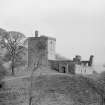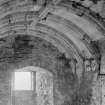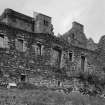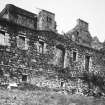Pricing Change
New pricing for orders of material from this site will come into place shortly. Charges for supply of digital images, digitisation on demand, prints and licensing will be altered.
Field Visit
Date 13 June 1928
Event ID 1099546
Category Recording
Type Field Visit
Permalink http://canmore.org.uk/event/1099546
Castle Campbell.
This castle, once known as Castle Gloom, stands nearly a mile north of Dollar on a spur of the Ochils at the head of a deep, densely wooded glen (SC 798520, SC 798524). Its actual site is a rocky mound, rising precipitously from the deep ravines formed by the swift, tumbling burns of "Care" and " Sorrow," which unite below the castle and continue down the glen as the Dollar Burn. Bank Hill and Gloom Hill rise on either side to elevations of 1128 and 727 feet respectively, and behind-that is to the north-are the more considerable heights of Saddle Hill (1633 feet) and Hillfoot Hill (1337 feet). Despite the melancholy sound of so many of the names the castle is a pleasant place, lying open to the sun and having a magnificent outlook southwards over the Forth and the plain beyond and around it.
The mound is less steep on the north, and it is from that side, therefore, that the castle is normally approached. The old way from Dollar was by a track which crosses the shoulder of Gloom Hill and joins a road running through the hills from Glen Devon, just before the latter reaches the castle. The more usual access, however, is by a modern path which runs directly up the glen. Immediately above the meeting of the streams and just beyond the Glencairn Bridge, where the burn of Sorrow is crossed, the cliff forming the southern boundary of the site is rent by a great fissure, called, Kemp's Score or Cutt."* This is mainly a natural formation, but roughly cut steps have been found beneath the debris that now fills it, and it would provide a short but dangerous route to the summit. The path proper keeps the outer side of the ravine and ascends the mound on the north. At the point where it begins to rise, there are re-entrants, which seem to be natural.
The buildings do not occupy the whole of the available ground on the top. Towards the south there are the remains of a garden with broken ground beyond, and beside "Kemp's Score" is an archway, evidently not of great antiquity and apparently built to shut off a small oval area with almost perpendicular sides. The castle attained its present form by a process of gradual development. The third quarter of the 15th century saw the erection of the oblong tower which stands at the northeastern corner of the present enclosure. It was self-contained but was evidently designed for attachment to a barmkin. Whether any part of the barmkin remains is not quite certain, but the tower itself is structurally the most complete of the castle buildings. In the 16th century the present enclosure was built, and the living accommodation of the castle increased by the provision of ranges of building against its south and east walls. At the close of the 16th or at the beginning of the 17th century the eastern range was altered, an incidental result of the alteration being to improve the means of communication within the tower, while some work was also done on the south range and on the wall of enclosure. To the same period maybe assigned the existing gateway to the courtyard, on the western side of which a one-storeyed building was built against the outside of the wall. Of the last addition, however, few traces have survived.
As castle and enclosure extended across the full width of the site, the only access to the garden and the ground beyond it was from within the courtyard through a vaulted transe passing under the southern range. The garden dates from the 16th century. It is equal in width to the enclosure and stretched 22 yards south of the main outer wall. It is now enclosed by a low roughly-built wall, in parts broken and ruinous, which terminates at the south-eastern angle in the remains of a small circular tower of indeterminate date, having a diameter of 8 feet 2 inches within walls 2 feet 3 inches thick.
[see RCAHMS 1933, 321-325, for a full architectural description]
HISTORICAL NOTE. - Castle Campbell, with the kirklands of Dollar, was originally held by the Earl of Argyll in feu-farm from the Bishopric of Dunkeld (1). Before 1490 the castle was called "the Gloume," but in that year Colin, first Earl of Argyll, secured an Act of Parliament changing the name to Castle Campbell (2). In 1645 the Marquis of Montrose, on his way from Fife to Stirling, burnt "the land of Castell Gloum, otherways called Castell Cambell” (3). Bishop Guthry records the burning of the parish of "Dollor" on this occasion by "Maclean and his people" in the service of Montrose, the parish "belonging to the marquis of Argyle" (4). It is usually said that at this time Castle Campbell was burnt, but in neither of these contemporary sources is there a statement to that effect.
RCAHMS 1933, visited 13 June 1928.
(1) Rentale Dunkeldense (S.H.S.), pp. 51-9,341, &c. (2) Acts Parl. Scot., ii, p. 222. (3) Britane's Distemper, by Patrick Gordon, pp.137-8. (4) The Memoirs of Henry Guthry, &c.,2pd ed. 1747, p. 191. Mark Napier in his Life of Montrose, p. 350, affirms the burning of the Castle, but his only reference is to Guthry.























